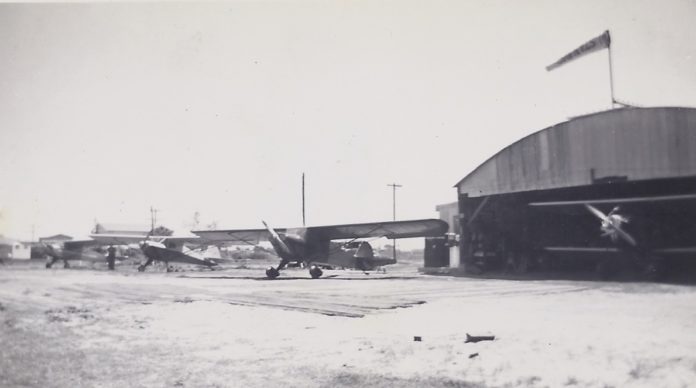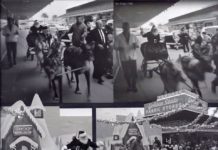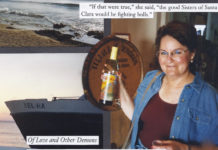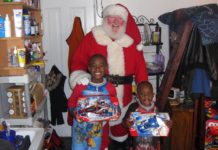Dolores Kott was born with aviation fuel in her veins. Her father, Arnold Peik (pronounced as Pike), a barnstorming pilot and flight instructor from Wisconsin, opened Peik Airport on the southeast corner of the Mission Bay mudflats in 1935. Today, the 2,600′ runway at Peik would have extended west onto Fiesta Island. Back in the 1930s, this site was a dump that required massive effort to make it suitable for living and for flying.

Dolores explained her connection to the world of flight. “My brother, Leander, was born in 1927 when Lindbergh flew solo across the Atlantic. I was born in 1937, the year of the Hindenburg Disaster. Amelia Earhart was lost at sea that year. My parents knew her. My youngest brother, Roland, was born in 1940 when the Royal Air Force defeated the German Luftwaffe during the Battle of Britain. When I was young, everything in my family seemed to be related to aviation.”
“My parents were really squatters at Mission Bay. They made an airport out of nothing,” she began. “In 1947, the city condemned the airport and planned to dredge and develop Mission Bay. That took forever.”
“My parents often talked about the flood in 1937. Mr. Warfield had a nearby hog farm and his pigs were floating around the airport during the flood. My dad had a hard time keeping them from climbing on the planes. Mr. Warfield was an uncle of Wallis Simpson who married the King of England.”
“My dad was taught to fly by the great Tex Rankin. He also learned to be an airplane mechanic. As a young girl, it seemed my father could make anything. My brother Roland took after him that way.”
“He would take me up once in a while to cruise around and look at Mission Bay,” she said. “He always said he could teach people who couldn’t speak English to fly if they only understood four words: up, down, left and right.”
“My dad traded a plane to a carpenter and they built our 18’x24′ knotty pine house at the airport. They later added a screened-in porch. I loved it.”
“The Army took over during the war. They used barrage balloons as part of the costal defense and built barracks at the airport. The soldiers were nice to me. Once I wandered into one of their poker games late at night. They were glad it was me and not their commanding officer.” Dolores continued, “I remember going up with my father when he would drop parachutes to test them. It was fun to watch them drift down to earth.”
The Civil Aeronautics Administration maintained three tall radio towers beside the airport, but Dolores doesn’t remember their function. “They kept the weeds cleaned away and we were told to stay away from the towers,” she said.
“After the war, my dad leased the airport to Mr. Cooper and Mr. Nance and they operated the San Diego Flight Academy into the 1950s. The city finally closed the airport in ’57 when development of Mission Bay Park began.”
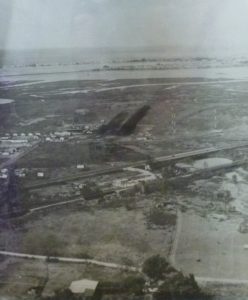
Peik Airport is not to be confused with San Diego Airpark and its 2,700-foot runway which opened shortly after World War II, closed in 1951 and became Clairemont Drive. Surprisingly little is known about the history of this airstrip.
Dolores continued, “I remember Howard Hughes flew in late one night. He had a twin-engine Cessna. My parents knew him from Yuma. They said he was just like any other pilot. I mainly remember the bright lights.”
“There were a lot of plane crashes when I was young and people often walked away from them.”
“My dad would dress up as Santa Claus at Christmas and fly around low in an open cockpit waving at people.”
Both of her brothers are deceased, leaving Dolores as the sole survivor of Peik Airport. She has an unlikely memory of her father’s airfield.
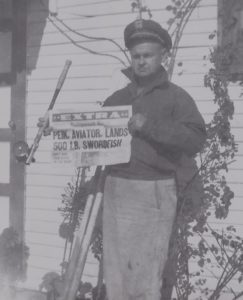
“My main memory of the airport may be that my dad and his friend built a 48′ fishing boat there. He named the boat, Lydia, after my mother. The boat became part of the H&M sport fishing fleet, but he never made any money from fishing.”
Arnold Peik aimed high. He was always thinking of new ways to make a buck, but the old barnstormer never became a “high-flying” tycoon. Time and the tides washed away his footprint in the mud of Mission Bay, but Peik was undeniably a colorful man… an enterprising man… and a man unafraid to take a chance.
His dreams of success were always bigger than his fear of failure.
Email:Bill@ClairemontTimes.com
To read of the Squaremont Columns visit: here

